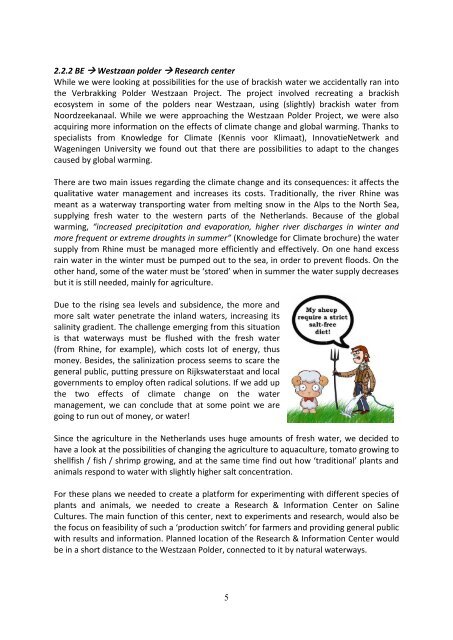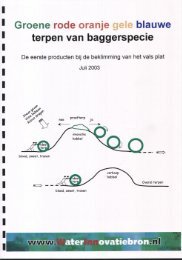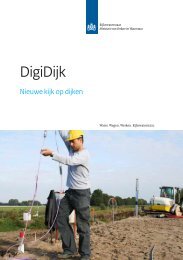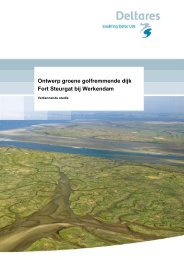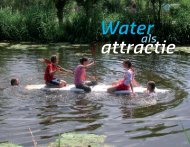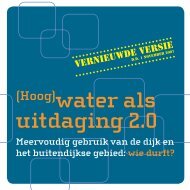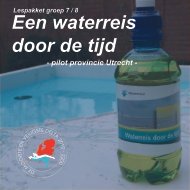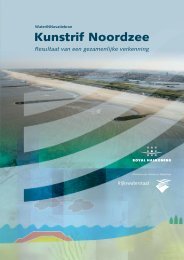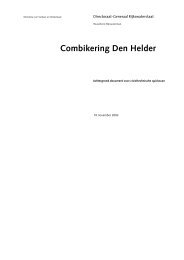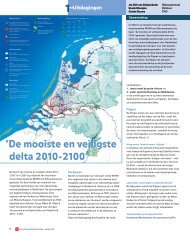Creating opportunities to adapt to climate change through innovative ...
Creating opportunities to adapt to climate change through innovative ...
Creating opportunities to adapt to climate change through innovative ...
Create successful ePaper yourself
Turn your PDF publications into a flip-book with our unique Google optimized e-Paper software.
2.2.2 BE Westzaan polder Research centerWhile we were looking at possibilities for the use of brackish water we accidentally ran in<strong>to</strong>the Verbrakking Polder Westzaan Project. The project involved recreating a brackishecosystem in some of the polders near Westzaan, using (slightly) brackish water fromNoordzeekanaal. While we were approaching the Westzaan Polder Project, we were alsoacquiring more information on the effects of <strong>climate</strong> <strong>change</strong> and global warming. Thanks <strong>to</strong>specialists from Knowledge for Climate (Kennis voor Klimaat), InnovatieNetwerk andWageningen University we found out that there are possibilities <strong>to</strong> <strong>adapt</strong> <strong>to</strong> the <strong>change</strong>scaused by global warming.There are two main issues regarding the <strong>climate</strong> <strong>change</strong> and its consequences: it affects thequalitative water management and increases its costs. Traditionally, the river Rhine wasmeant as a waterway transporting water from melting snow in the Alps <strong>to</strong> the North Sea,supplying fresh water <strong>to</strong> the western parts of the Netherlands. Because of the globalwarming, “increased precipitation and evaporation, higher river discharges in winter andmore frequent or extreme droughts in summer” (Knowledge for Climate brochure) the watersupply from Rhine must be managed more efficiently and effectively. On one hand excessrain water in the winter must be pumped out <strong>to</strong> the sea, in order <strong>to</strong> prevent floods. On theother hand, some of the water must be ‘s<strong>to</strong>red’ when in summer the water supply decreasesbut it is still needed, mainly for agriculture.Due <strong>to</strong> the rising sea levels and subsidence, the more andmore salt water penetrate the inland waters, increasing itssalinity gradient. The challenge emerging from this situationis that waterways must be flushed with the fresh water(from Rhine, for example), which costs lot of energy, thusmoney. Besides, the salinization process seems <strong>to</strong> scare thegeneral public, putting pressure on Rijkswaterstaat and localgovernments <strong>to</strong> employ often radical solutions. If we add upthe two effects of <strong>climate</strong> <strong>change</strong> on the watermanagement, we can conclude that at some point we aregoing <strong>to</strong> run out of money, or water!Since the agriculture in the Netherlands uses huge amounts of fresh water, we decided <strong>to</strong>have a look at the possibilities of changing the agriculture <strong>to</strong> aquaculture, <strong>to</strong>ma<strong>to</strong> growing <strong>to</strong>shellfish / fish / shrimp growing, and at the same time find out how ‘traditional’ plants andanimals respond <strong>to</strong> water with slightly higher salt concentration.For these plans we needed <strong>to</strong> create a platform for experimenting with different species ofplants and animals, we needed <strong>to</strong> create a Research & Information Center on SalineCultures. The main function of this center, next <strong>to</strong> experiments and research, would also bethe focus on feasibility of such a ‘production switch’ for farmers and providing general publicwith results and information. Planned location of the Research & Information Center wouldbe in a short distance <strong>to</strong> the Westzaan Polder, connected <strong>to</strong> it by natural waterways.5


